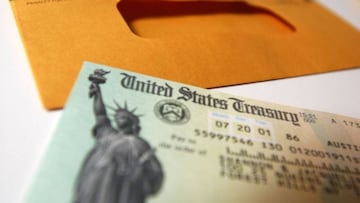Stimulus check: when is the deadline to claim and get the money?
Millions of Americans who are eligible for a coronavirus stimulus check payment are yet to claim, and time is running out to apply.

Time is running out for people in the United States who are yet to receive their first Economic Impact Payment (EIP), which are commonly referred to as coronavirus stimulus checks (a second round is looking more likely). The IRS has been trying to locate these individuals so that everyone who is eligible for this one-time payment (although further support continues to be discussed) can receive it. The cut-off date to register is Saturday 21 November.
After the CARES bill was signed into law in March the IRS began sending out $1,200 checks for individuals, with an additional $500 for any dependents under the age of 17. Those who file annual income tax statements should have received theirs automatically but anyone who does not file with the IRS may not have been included.
The Government Accountability Office estimates that there are around 8.7 million eligible individuals who have yet to receive their stimulus check from the IRS.
- People that didn’t file an income tax statement in 2018 and 2019
- People who don’t normally file income taxes may still be eligible for a payment. Those with an income below $12,200 ($24,400 for married couples)
- People who get veterans or railroad retirement, Social Security Income (SSI) or Social Security benefits.
- Homeless or transient individuals & families
These individuals can get instructions on how to get their payment by using the IRS’s non-filers tool.
The IRS needs your help to locate these people
If you know someone in these groups it could make a real difference for them and the IRS is trying to get the word out. So, if you know anyone who might qualify for a payment reach out and let them know.
People who receive their income from government payments from different programs
They might not have to file income tax returns but they are still eligible for the coronavirus stimulus check. They will need to contact the IRS and use the non-filer tool to get their EIP payment.
Adults with low-income who don’t usually file tax returns because they are under the minimum for filing
If the people in this group have moved recently and haven’t filed the IRS will have difficulty locating them to make sure they receive a payment. They will need to contact the IRS and use the non-filer tool to get their EIP payment.
Parents who don’t usually file a tax return may still be due an Economic Impact Payment – that’s $1200 PLUS $500 per child. Help #IRS get them their money: https://t.co/FjXU7pGWeq pic.twitter.com/CljX190XlV
— IRSnews (@IRSnews) October 27, 2020
College students who aren’t claimed as dependents may be among those who qualify for the relief funds
If they are supporting themselves financially these funds could be crucial. They will need to contact the IRS and use the non-filer tool to get their EIP payment.
People who are homeless or transient
Even though they haven’t paid taxes or filed an income return still qualify for the stimulus check. The deadline to enter a claim for payment is 21 November, 2020.
- Their name plus a mailing address and an email address. (People can ask a friend, family member, or shelter to use their address.)
- Date of birth and valid Social Security number (SSN)
- Bank account information, if any
- Identity Protection PIN, if they've gotten one from the IRS
- License or state ID, if any
- Name, SSN, and relationship for each qualifying child
What do individuals need to do to register?
To submit a claim for the Economic Impact Payment you must check with the IRS to see if you are eligible. You can do this by going to the IRS non-filer tool.
Those eligible who submit their bank account information will receive a direct deposit by the end of the year. If the person can only provide an address, the IRS will send a check in the mail but this will obviously take longer. You can track your stimulus check in the mail by using the US Postal Service's Informed Delivery tool.
How to spot, avoid, and report imposter scams: https://t.co/hqJVwYMf34 #SayNoKeepYourDough pic.twitter.com/9LkY3fHBn6
— FTC (@FTC) October 27, 2020
Related stories
If eligible individuals fail to meet the 21 November deadline, they will have to file a federal income tax return in 2021 in order to claim their EIP.
All individuals should be aware of scams to claim these funds, the FTC provides a list of 4 things you can do to avoid coronavirus relief payment scam.
- Don’t respond to calls, texts, or emails about money from the government—or anyone asking for your personal or bank account information. Government agencies like the IRS will not call, text, or email you about your relief payment.
- Don’t pay anyone to get your relief payment. There are no fees to get your money.
- Don’t respond to anyone who says your payment was too high, and tells you to repay the money by sending cash, a gift card, or a money transfer. That’s always a scam
- Never click on links in emails, texts, or on social media about your relief payment. Always start at irs.gov/coronavirus to check your eligibility, payment status, enter direct deposit information, or find out what to do to get your payment.